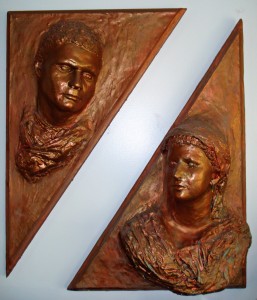 I suffer from a rather rare ailment I sometimes call the “classical bug”. This is characterized by total fascination with all things ancient, especially those concerning the ancient Greek and Roman civilizations.
I suffer from a rather rare ailment I sometimes call the “classical bug”. This is characterized by total fascination with all things ancient, especially those concerning the ancient Greek and Roman civilizations.
Spouses of those who have the “classical bug” must be very tolerant souls indeed. Witness my long suffering wife Krista who has submitted to such indignities as having her face immersed in slimy goo to indulge my desire for a pair of Greco-Roman busts.
She even listens with interest when I tell her all about my new ushabti (an Egyptian burial figurine), Roman unguentarium (an ancient glass ointment jar) or Philip II sestertius (a large 3rd century Roman bronze coin which actually has a picture of a moose on its reverse). On vacations she follows patiently or lets me go off on my own to spend hours sorting through antique shops and museums.
To my credit, when we got married I did not insist that the ceremony be performed in Latin, nor did the justice of the peace have to wear a toga. We did, however, have a pair of Celtic harpists in attendance, adding a certain flavor to the proceedings. Krista made one additional concession.
 I hate rings, but I love looking at ancient art. A plain wedding band just did not turn my crank, so to speak. My (at the time) prospective spouse asked what exactly I might find suitable for the ceremony.
I hate rings, but I love looking at ancient art. A plain wedding band just did not turn my crank, so to speak. My (at the time) prospective spouse asked what exactly I might find suitable for the ceremony.
After much thought I decided that it would be unlikely I would find an ancient ring that would fit my hand, and the thought of modifying one was somehow sacrilegious. Putting an ancient intaglio (an incuse relief carved gemstone) into a modern reproduction of a Roman signet ring seemed a reasonable alternative. I like the idea that intaglios were often carved by the same people who did engraving for the Roman Mint, the so-called “celator”.
My next problem was where to find an appropriate intaglio. When I decided to have our busts done in Roman style, we decorated the pieces with real ancient Roman jewelry, much as was done in ancient times.
I perused the catalogs of various dealers and found an English dealer who offered the perfect pieces. Krista’s bust, looking the perfect second century C.E. Roman matron, now sports an attractive gold earring complete with a green stone (her birthstone is the emerald) and a tiny filigreed heart. My toga is “held in place” by a two thousand year old fibula.
I sent off another query to Mr. Martin who came through in the pinch once more. Shortly after my letter was sent, a lovely red carnelian intaglio arrived. It was engraved in Third Century C.E. style with, on the right, a well-muscled Sun god, “soli invicto”, seated facing left. On the left stands a curvaceous Moon goddess facing right. Between the two is a star and a crescent moon. I marveled at how so much detail could be conveyed in such a small space. This was the ideal pattern for a wedding ring. Could the jewel have originally been in a ring or pendant intended as a gift from one ancient Roman spouse to another?
 The next step was to find a jeweler who would set the stone. A local goldsmith, Glenn Fawcett, did the kind of work I liked. Entering his shop I told him I had “an old stone” I’d like set.
The next step was to find a jeweler who would set the stone. A local goldsmith, Glenn Fawcett, did the kind of work I liked. Entering his shop I told him I had “an old stone” I’d like set.
“Nineteenth Century?” he asked. “No,” I replied, “a bit older”. His eyes lit up. “Oh, it must be eighteenth Century then.” “Actually, no” I answered. I showed him the stone and said it was approximately 1700 years old. Glenn was quite intrigued, especially since this was about 1500 years older than any other gem he’d worked with. We designed a ring very much in the style of a Roman signet ring.
A month later the ring was ready. When we entered the shop and looked at it, it was perfect. Glenn had even counter-marked his work in a manner which would amuse any collector of ancient Greek or Roman Republican coins … with a tiny faucet!
The ceremony went flawlessly and the ring slid easily onto my finger as the harpists plucked a Celtic wedding song.
Two years later our union was blessed with the birth of a beautiful little girl. Her name is Ariana, which means “silver” in Gaelic, “holy” in Greek, and is the Latin form for King Minos’ daughter, Princess Ariadne. (You expected maybe Tiffany?) Believe it or not, my wife picked the name out!
Photo Credits
All photos © George Burden
“Wedding Ring”
“Photo of life-sized busts of Geroge and his wife Krista (George is the one on the left).”
“A small bronze satyr, the amorous half man half goat of classical mythology.”


[…] This post was mentioned on Twitter by Dan L Hays and christopherholt, Life As A Human. Life As A Human said: New Article, A Classical Romance – http://tinyurl.com/35mssr4 […]